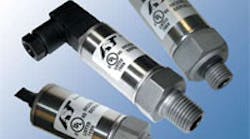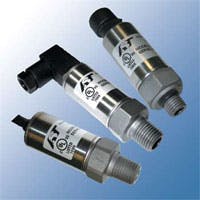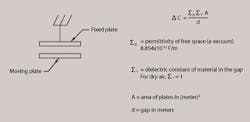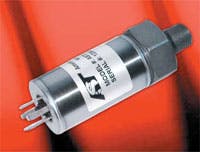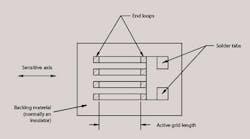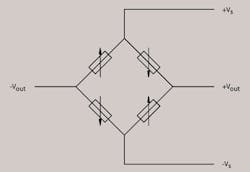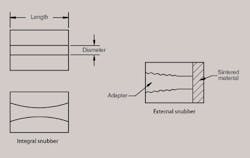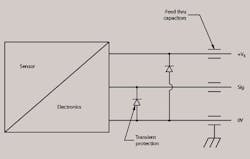Over time, better sensing technologies and the availability of low cost microprocessors and controllers accelerated the growth of hydraulic controls. Today, pressure measurements play an important role in determining the health of hydraulic systems by means of overall performance, safety, and feedback. Depending upon the application, most modern hydraulic systems operate from 1000 to 10,000 psi; however there are some that may go as high as 60,000 psi.
Pressure measurements can be accomplished with a simple on-off pressure switch or an electronic pressure sensor that offers a linear electronic output signal. Electronic pressure sensors are replacing pressure switches, due to their flexibility and performance; however, there are topics that must be addressed for performance and reliability in hydraulic applications. Pressure sensing technologies, sensor packaging, hydraulics transient protection, and EMI/RFI protection must be considered carefully for each application.
Pressure sensing technologies
The two main technologies for pressure sensing are capacitive and piezoresistive. Capacitive technology employs gap sensing by means of a capacitance change between two plates; one fixed and other moving, as shown in Figure 1. This capacitor is normally connected to a complex electronic circuit that will covert the capacitance to an output signal such as 1-5 V or 4-20 mA. Because the change of capacitance is in the range of 1 pico Farad to 1 femto Farad, the electronic circuitry is placed closely to the sensing plates, to minimize stray capacitance. This tends to limit the operating temperature of the sensor, as there is a short distance between the media and capacitor.
If a metal or doped semiconductor is stretched or compressed, its resistance changes because of dimensional changes (length and cross-sectional area) and resistivity change (this latter property is called piezoresistance).
Strain gauge technology is used to measure the change in length from L to ΔL and resistance change from R to ΔR. The strain sensitivity or gauge factor, G, can be calculated by:
(ΔR R) (ΔL L)
For metal strain gauges, the typical gauge factor is 2. These strainmeasuring devices are normally called strain gauges and come in different sizes. Figure 2 shows an outline of a bonded foil strain gauge. Bonded foil strain gauges are made from nickel chromium or nickel constantin material and typically have a Mylar insulator backing. This allows one to glue the gauge to a metallic or ceramic substrate. Thin film gauges, fabricated by sputtering metal on an insulated substrate, do not require any glue for bonding. In the early 1960s, semiconductor gauges were developed to offer higher gauge factors (from 55 to 200) with a smaller package size. Semiconductor gauges can be fabricated in two ways: the use of bulk silicon or germanium material that has been doped in either P-type such as boron or N-type material such as phosphorus to provide the electrical and thermal performances; ion implanting using P and N types of material together to form a P-N junction. These strain gauges are normally connected in a Wheatstone bridge configuration as shown in Figure 3 (four active arms are shown for maximum compensation) to provide a limited temperature compensation. For metal or thin film strain gauges, the output signal is 3mV/V with an operating strain of 1100 microstrain whereas semiconductor gauges will provide up to 50mV/V with 300 microstrain.
Pressure sensor packagingMost low cost ceramic capacitive sensing elements employ a ceramic diaphragm made with an Alumina 96, machined pressure port, retainer ring, housing, and O-rings. The ceramic diaphragm is normally held to the pressure port by means of a primary O-ring. A secondary O-ring is used with the retaining ring on the opposite side to hold the ceramic diaphragm when pressure is applied. In this design, the media comes in contact with the ceramic diaphragm, primary Oring, and pressure port material. For low-pressure applications, the ceramic diaphragm tends to be large and thin. This has the potential for failure under high shock and vibration conditions.
Ceramic sensors are used in industrial and off-road applications up to 1500 psi; however, the proof pressure (also known as the overload pressure) is restricted to 1.2 times the rated pressure. Today, this technology has limited use above 1500 psi, due to the availability of low cost strain gauge technologies with much better performance and longevity. In cyclic environments, the proof pressure rating must be reduced to same as operating pressure range to avoid failure of the O-ring seal. Since this design does not incorporate a hermetic seal, these sensors are not suitable for operation in ammonia, hydrogen, oil and gas production, hydraulics, oxygen service, and many other critical mild to harsh applications. The O-ring can be specified in a range of materials to deteragainst specific media attack that can cause system failure in certain abusive environments. Sensor manufacturers typically provide a list of O-ring materials such as Buna, Viton, and EPDM that can be specified by the customer.
Since the metal foil strain gauges tend to be large, they are normally put on a beam or diaphragm prior to welding to a pressure port. Thin film sensors are smaller, but they also need to be welded to a pressure port. In both cases, the welds need to be deep enough so that they do not fail under normal and overload conditions — operating above 2500 psi.
Under high cyclic and pressure conditions, where the pressure pulsations can vary by 50% of the pressure sensor range, the sensor package design must incorporate a mechanism to make sure that the weld is under compression to avoid sensor failure. Because both metal foil and thin film technologies have low outputs at high operating strains (typically 1000 microstrain), the diaphragm material must be carefully selected so there is enough room for overpressure without sacrificing shift in sensor performance. Common diaphragm materials used in metal foil and thin film sensors tend to be 15-5, 17-4 and 17-7 PH high strength stainless steels with yield strengths up to 190,000 psi and low thermal coefficient of expansion. The pressure ports must be of the same material as the diaphragm to avoid any separation of the welds under thermal conditions.
Sensors employing semiconductor strain gauge technology can be broken into two categories; oil-filled sensors employing a thin isolation diaphragm and ion implantation technology and the emerging diffusion bonded bulk silicon Krystal Bond Technology. Oil-filled piezoresistive sensors mainly employ a small silicon chip with ion implanted strain gauges, isolated from the real world by means of a thin metallic membrane (typical thicknesses between 0.001 and 0.0015 in., depending upon the pressure range).
With bulk semiconductor strain gauge technology, the strain gauges are directly mounted onto a machined sensing element, where the diaphragm and pressure port are machined in the same process. This eliminates the problems associated with welds, oil filled cavities, and internal O-rings. The use of a direct inorganic diffusion process allows semiconductor gauges to be placed precisely on a metallic diaphragm efficiently and accurately on the side of the diaphragm that is not exposed to the media. The hermetic design is excellent for high cyclic environments associated with hydraulic pumps and motors. The high gauge factor, along with low operating strain, allows the diaphragm to be thick. This offers excellent proof and burst pressures.
Pressure spikes and transient protection
Rapid opening and closing of valves and solenoids in hydraulic systems tends to generate rapid, high frequency pressure spikes and transients that may last from a few microseconds to hundreds of milliseconds. The amplitude of these fast moving transients can be up to 20 times the rated pressure of a system, and will destroy electronic pressure sensors unless they are protected using snubbers and restrictors.
These protection devices can be installed as an integral part of the sensor or as a stand-alone device. The devices, while protecting the sensor from damaging fast moving transients, can dampen the response time of the sensor (depending upon the design). Figure 4 shows details of integral and external pressure spike snubbing techniques. For system optimization, such as response time and snubbing, the length, L, and diameter, D, must be carefully selected. In an ideal condition, the snubber must be able to snub all signals that are between 100-150% of applied pressure to maintain fast throughput, but remains dependent upon the type of sensing technology and packaging.
EMI/RFI protection
In mobile hydraulic applications, electrical pollution in the form of fast electrical transients, Electro Static Discharge (ESD) and EMI/ RFI must be contained for system stability. Examples of this interference include communications equipment, switching power supplies, welding equipment, and electric motors. The sensor package must not generate or be influenced by unwanted external electrical signals from 100 kHz to 2 GHz. It must also be able to withstand radiated and conducted susceptibility and operated within its published specs in critical applications such as mobile cranes, scissor jacks, forklifts and many others. Typical protection used can be seen in Figure 5.
| The danger of pressure spikes System control electronics — such as PLCs with millisecond scan times — are not fast enough to detect spikes of such short duration. Often, the first indication that a system is generating pressure spikes is a positive shift in a pressure transducer’s zero output. System control electronics commonly indicate the shift in transducer output as a pressure out-of-range condition, which could cause the system controller to shut down. Pressure transducers are the components most vulnerable to damage from pressure spikes. Transducers, with much quicker response, react to spikes and can show signs of having been over-pressurized. This is not because the transducer is less durable than the mechanical gauge it replaced. Actually, a transducer designed for severe service should have been specified. Spikes also damage the machines that generate them. The erratic flow of liquid, common in systems that generate spikes, reduces efficiency and accelerates wear on valve ports and seals. (Note that pressure spikes do not pose serious problems in pneumatic systems because the air is compressible, which tends to dampen shock. Cyclic pressure surges, caused by pulsation from compressors, pose a greater potential problem because the pressure surges — while not as sharp — occur repeatedly and frequently.) Pressure spikes usually can be detected with an oscilloscope through a transducer of, say, five times the normal operating pressure range. Once it is determined that spikes exist in a system, any of several practices can be used to prevent them from damaging the transducer. A transducer with a higher pressure rating can be used. However, doing so sacrifices accuracy in the normal operating range because a transducer with a wider operating range has poorer resolution. As an alternative, a snubber can be used to dampen the spike. A snubber is an orifice installed in piping between the transducer and the source of the spike. A potential disadvantage of this practice is that it slows the response of the measurement. If neither measurement resolution nor response can be compromised, a transducer that can tolerate spikes should be specified. Obviously, these transducers cost more. This information came from the 2008/2009 edition of the Fluid Power Handbook & Directory. To order your copy in printed form or on CD-ROM, visit www.hydraulicspneumatics. com and click on the Bookstore button. |
